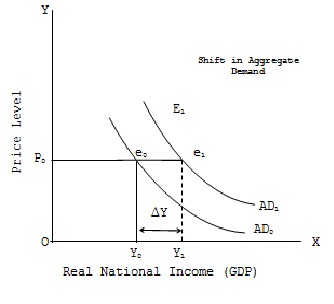Multiplier measures the magnitude to changes in equilibrium level of GDP in response to a given change in autonomous spending on the assumption that price level remains unchanged. Thus, at a given price (P0), the AE curve shifts upwards from AE0 to AE1 due to increase in autonomous spending equal to ΔA. Due to this increase in autonomous spending, national income increase from Y0 to Y1 by ΔY. The multiplier is thus K = ΔY / ΔA.
This upward shift in AE and the consequent increase in national income shifts the AD curve rightwards from AD0 to AD1. This upwards shifted new aggregate demand curve AD1 is parallel to the original curve AD0 at a horizontal distance equal to ΔY(i.e., distance equal to Y0 to Y1 which is same as from point e0 to e1) while the price level remains the same at P0. Similarly, a fall in autonomous spending (with price level remaining unchanged) will cause a leftward horizontal shift in AD from e1 to e0.

Thus, a change in any of the exogenous variables except for price level causes shifts in AD curve. Such shifts in AD curve are called Aggregate Demand Shocks.
SUBMIT ASSIGNMENT NOW!